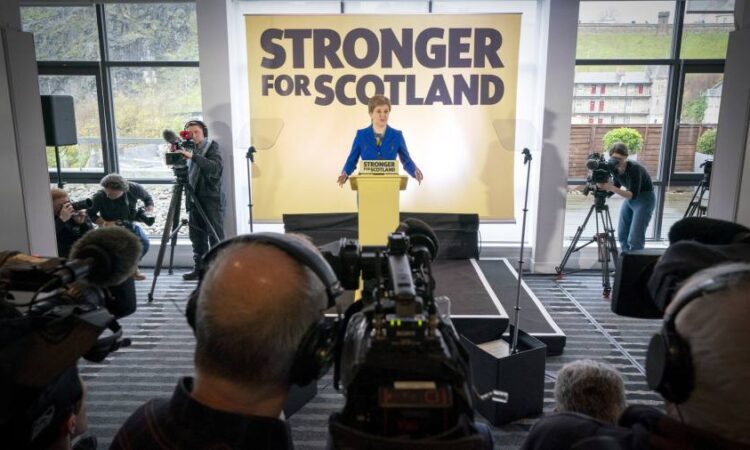
The writer is director of the think-tank Reform Scotland
Scotland has never recovered from the independence referendum held in 2014. The angry divisions caused by that fiery debate pitted friend against friend, wives against husbands, parents against children, and have dominated the country’s discourse and democracy ever since.
Nicola Sturgeon, who this week announced her surprise resignation after eight years as first minister and leader of the separatist Scottish National party, has been both source and beneficiary of these tensions. Despite early indications that she wanted to reach out to those who voted in favour of remaining in the UK — a preference which won out by 55-45 — the latter years of her leadership saw relentless attempts to force a rerun.
Scotland has been stuck in a loop, with the arguments for and against independence relitigated on a weekly basis, to the exclusion of almost everything else. For unionists, who would prefer to talk about deep-seated, mainstream problems, this has been both maddening and exhausting. They will not mourn Sturgeon’s departure.
Since losing the independence referendum in 2014, the SNP has triumphed in every election it has fought at a national, devolved, European and local level. This has been in no small part due to the charismatic Sturgeon, whose personal popularity consistently dwarfed that of her opponents in Edinburgh and London. She has been the figurehead of an independence movement that saw its support climb from 45 per cent at the time of the referendum to hover around 50 per cent.
In recent months, however, the sheen started to come off. Sturgeon announced a plan to use the approaching UK general election as a “de facto” second referendum: if the SNP gained more than 50 per cent of the vote it would begin independence negotiations with Westminster. This presumption was disliked by Scotland’s voters. Equally unpopular was an attempt to reform the rules around changing gender, removing the need for a medical diagnosis of gender dysphoria and reducing to 16 the age for allowing a change. Even around a third of SNP voters supported a decision by the UK government to block the measures from becoming law.
After these miscalculations, public support for independence, for the SNP and for Sturgeon finally began to fall. In recent weeks, a need for change at the top had been increasingly discussed, but at some future point.
After her shock departure, Unionists scent the opportunity they’ve been waiting for. The independence movement must find a new leader, but Sturgeon has been so singularly dominant that the contenders to succeed her have relatively low public profiles. The contest is likely to be less about personalities or governing competence and more about who can offer the most compelling strategy for securing independence. The risk, as the Conservatives found with the ill-fated Liz Truss, is that the candidates are dragged by their selectorate — the SNP members — into crowd-pleasing but undeliverable promises about how and when.
Those candidates, if they have an eye to wider Scotland, should instead answer questions that ultimately proved beyond Sturgeon. How will a new leader reverse the party slide in the polls? How would they push support for independence up towards the 60 per cent mark that most observers believe is necessary to secure and win a second referendum? What, after 16 years in power, is the point of an SNP administration in Edinburgh that has avoided meaningful reform and modernisation of public services?
On the substance, there are also tricky challenges: how would an independent Scotland that rejoined the EU manage an economic border with England, its largest market by some distance? What would be a convincing plan for which currency a separate Scotland would use? What about the impact on pound-denominated savings and pensions?
Amid this upheaval and debate, the Labour party intends to seize its chance. It is the only credible alternative to the SNP as the devolved government, but always struggled against the election-fighting genius of Sturgeon and, as a unionist party, lost traditional supporters to the independence cause. It currently holds only one Scottish seat in the Commons.
However, Labour has recently begun to claw its way back up in the polls in Scotland, and belief that Keir Starmer could take over as prime minister will provide a further boost. Labour strategists hope to win somewhere between 15 and 20 of the 59 Scottish seats at Westminster in the UK general election, likely to be held next year. The party would then campaign for the next Holyrood election in 2026 promising that Labour administrations north and south of the border would work in harmony to improve Scotland’s lot — in contrast to more than a decade of provocation between rightwing Tory Westminster and leftwing SNP Holyrood.
Unionists are desperate for an end to the obsessive debate about breaking up the UK, which has kept Scotland divided and distracted since 2014 and which threatens the continued existence of the British state. For that to happen, they must persuade Scotland’s voters to move on, at last, from putting their faith in the SNP. Sturgeon’s departure might be their best — and, when it comes to the Union, last — chance.



